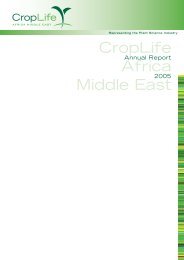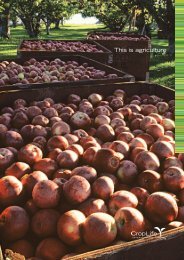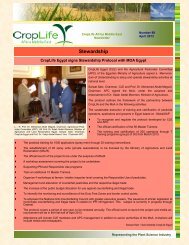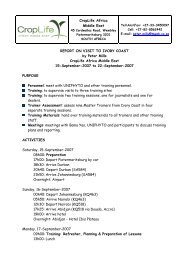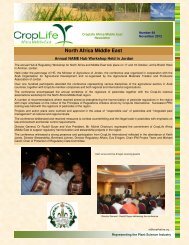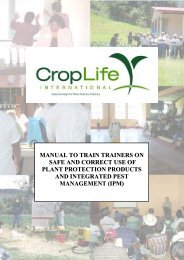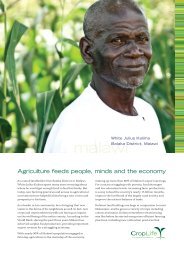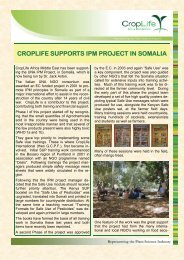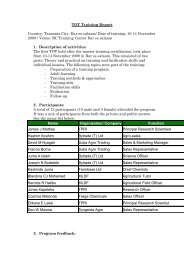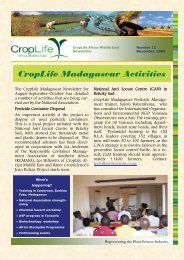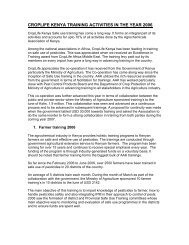Newsletter January 2013 - CropLife Africa Middle East
Newsletter January 2013 - CropLife Africa Middle East
Newsletter January 2013 - CropLife Africa Middle East
Create successful ePaper yourself
Turn your PDF publications into a flip-book with our unique Google optimized e-Paper software.
Page 8<br />
<strong>CropLife</strong> <strong>Africa</strong> <strong>Middle</strong> <strong>East</strong> <strong>Newsletter</strong> Number 86<br />
<strong>January</strong> <strong>2013</strong><br />
Tanzania cont..<br />
More than 90 percent of the cotton is produced to the south of Lake Victoria in Mwanza, Shinyanga, Mara, Tabora, Kigoma, and<br />
Singida region, with just three of them – Singida, Mwanza and Shinyanga – accounting for over 80 percent of the crop; the rest<br />
comes from the <strong>East</strong>ern parts of the country.<br />
With Bt cotton, we will be talking about more than the miserly 410,000 ha which are currently being sown to cotton during most<br />
farming seasons, and at almost zero risk from pest infestation.<br />
In the meantime, climate change is also for real – and ‘going biotech’ is about the best policy decision we could be making at the<br />
moment.<br />
Elsewhere across the world, biotechnology is proving to be the best way to providing food for a hungry tomorrow. The most<br />
compelling testimony to biotech crops is that, in the period 1996 to 2011, millions of farmers in 29 countries worldwide, made<br />
independent decisions to plant and replant biotech crops.<br />
One principal reason underpins the trust and confidence of risk-averse farmers: biotech crops deliver sustainable and<br />
substantial, socioeconomic and environmental benefits.<br />
As a resource-poor country, Tanzania cannot afford to feed on the fears of a largely uninformed anti-GM lobby – some of whose<br />
opponents eat GM food or survive on GM medicinal products even as they bad-mouth them.<br />
SOURCE: THE GUARDIAN - TANZANIA<br />
Malawi<br />
Scientists at Malawi’s leading agricultural college, Bunda, have disclosed that the first-ever genetically modified cotton<br />
‘confined field trial’ will start this growing season at college located on the outskirts of the capital Lilongwe.<br />
One of the scientists Dr Moses Maliro said that the genetically modified cotton, commonly known as BT cotton, would be<br />
planted once Bunda receives sufficient rains for planting.<br />
“By now we are at a stage whereby the seed for this variety is already in the country”, he said. “It is being kept under the<br />
custody of the Department of Environmental Affairs waiting for the next steps to treat it and then planting as soon as the rains<br />
come at Bunda.”<br />
The seed was procured from South <strong>Africa</strong>, which is now celebrating 15 years of growing and commercialization of genetically<br />
modified crops including cotton.<br />
The BT cotton trial at Bunda commences this year after it failed in the last growing season due to delays in procuring the seed,<br />
among other bureaucratic problems.<br />
It took almost two years since Bunda made the application to the bio-safety regulator hosted by the environmental affairs<br />
department for the trial to be approved on October 7, 2011.<br />
As the trial for the genetically modified cotton starts, some modifications have been made, according to Dr Maliro, a member of<br />
a seven-man team overseeing the research at Bunda College.<br />
Instead of conducting a trial for a variety of cotton that will both be resistant to bollworms and tolerant to herbicides, only one<br />
trait - the bollworm resistant (Bollgard II) - will be tested.<br />
“With the delay in mobilizing the resources, it become cheaper to just look at one event instead of looking at the two events<br />
and at the moment the pest is the major problem and should herbicide tolerant variety be necessary, I am sure that could be<br />
implemented later on,” disclosed Dr Maliro.<br />
The seasoned crop breeder said by the end of this growing season<br />
Malawians will be updated on initial results of the trial which might<br />
take up to three years to come up with conclusive results.<br />
“Stakeholders will be briefed on how the crop is performing and what<br />
has the data shown because the BT cotton will be compared against<br />
the local variety. So, yes, every stakeholder needs to know how it has<br />
performed; is it beating our local varieties and can we take it for<br />
further trials in other locations?” he alluded to some of the aspects on<br />
which the public will updated<br />
Representing the Plant Science Industry





